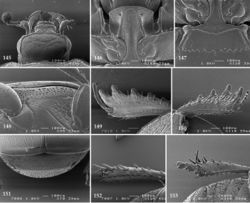Hypocaccus\according to Lackner et al 2017
| Notice: | This page is derived from the original publication listed below, whose author(s) should always be credited. Further contributors may edit and improve the content of this page and, consequently, need to be credited as well (see page history). Any assessment of factual correctness requires a careful review of the original article as well as of subsequent contributions.
If you are uncertain whether your planned contribution is correct or not, we suggest that you use the associated discussion page instead of editing the page directly. This page should be cited as follows (rationale):
Citation formats to copy and paste
BibTeX: @article{Lackner2017ZooKeys, RIS/ Endnote: TY - JOUR Wikipedia/ Citizendium: <ref name="Lackner2017ZooKeys">{{Citation See also the citation download page at the journal. |
Ordo: Coleoptera
Familia: Histeridae
Name
s.str. – Wikispecies link – Pensoft Profile
Diagnosis
From the sole Australian representative of the subgenus Nessus, H. (N.) interpunctatus interpunctatus, members of the nominotypical subgenus differ by larger size and presence of several deep rugae on otherwise almost glabrous frontal disc. From the sole Australopacific member of the subgenus Baeckmanniolus, H. (B.) varians varians, the two species of the nominotypical subgenus are easily separated by the presence of punctation on the pronotum.
Biology
Both species of the nominotypical subgenus that occur in Australopacific Region are littoral, occurring under wrack on beach, one specimen of H. (H.) brasiliensis from Australia was also found on a riverbank.
Distribution
Two very similar littoral psammophilous species, H. (H.) brasiliensis and H. (H.) sinae are present in Australopacific Region (Figs 755, 756, 760). Both species are most likely invaders from north (sensu Matthews and Bouchard 2008[1]: 17), as they occur in the Palaearctic and Indo-Malaysian Regions and the genus Hypocaccus is widely represented there too. The species H. (H.) brasiliensis is tropicopolitan, distributed along beaches in all warmer regions around the globe (Mazur 2011[2]); in Australia it was also found inland on a riverbank of the Colo River (Fig. 756).
Remarks
Regarding the differences between the nominotypical subgenus and subgenus Baeckmanniolus, Bousquet and Laplante (2006[3]: 80, 196) mention another character, the number of rows of denticles on the outer margin of metatibia (two in Hypocaccus s. str. versus three in the subgenus Baeckmanniolus) and treat the subgenus Baeckmanniolus as a distinct genus. For more discussion see Lackner (2010[4]: 145).
Key to the species of the subgenus Hypocaccus C. Thomson, 1867 of the genus Hypocaccus C. Thomson, 1867 occuring in the Australopacific Region
Taxon Treatment
- Lackner, T; Leschen, R; 2017: A monograph of the Australopacific Saprininae (Coleoptera, Histeridae) ZooKeys, (689): 1-263. doi
Images
|
Other References
- ↑ Matthews E, Bouchard P (2008) Tenebrionid Beetles of Australia: Descriptions of Tribes, Keys to Genera, Catalogue of Species. Australian Biological Resources Study, Canberra, 398 pp.
- ↑ Mazur S (2011) A concise catalogue of the Histeridae (Coleoptera). Warsaw University of Life Sciences, SGGW Press, Warsaw 332 pp.
- ↑ Bousquet Y, Laplante S (2006) The Insects and Arachnids of Canada. Part 24. Coleoptera Histeridae. NRC Research Press, Ottawa, Ontario, Canada, 485 pp.
- ↑ Lackner T (2010) Review of the Palaearctic genera of Saprininae (Coleoptera: Histeridae). Acta Entomologica Musei Nationalis Pragae, 50 (Supplementum): 1–254.








